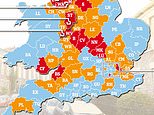Scientists estimate that the current cost of getting just one pound of material up to the moon and back comes to nearly $100,000 — a steep penalty for overpacking.
And now NASA is looking to crowdsource solutions that would help future astronauts more efficiently reuse the material they bring up to Earth's natural satellite, offering $3 million in cash prizes via its new 'LunaRecycle Challenge.'
'Astronauts will need to make the most of everything they bring with them, even their garbage,' the US space agency said in a video promoting the competition.
LunaRecycle's focus, the agency noted, would be 'non-gaseous, non-biological, and non-metabolic' solid waste: 'things like packaging, fabrics and structural elements.'
The end goal is to dream up innovative and hyper-efficient new ways to transform this trash into 'usable products' that support 'off-planet science and exploration.'
Phase 1 of the competition will carry a $1 million-prize purse and allow innovators to compete along two different tracks.
A 'Digital Twin' track will accept submissions of virtual simulations of the contenders' technology in action, incorporating real world data, and a 'Prototype Build' track will take on teams developing detailed designs of their recycling inventions.
NASA said that Phase 2 would be 'contingent on the emergence of promising submissions in Phase 1,' but would also bring with it $2 million in potential winnings.



Management of Challenge will be led by the director of space technologies and engineering research at the University of Alabama, Dr Rajiv Doreswamy.
But the southern school's College of Engineering will be coordinating with NASA, via its historic Marshall Space Flight Center in Huntsville, Alabama.
In a FAQ posted with the LunaRecycle Challenge, both the university and the federal space agency promised that it would not 'claim any intellectual property (IP) rights from the Teams' submissions.'
'All trade secrets, copyrights, patent rights, and software rights will remain with each respective Team,' according to the Challenge's FAQ.
Nevertheless, NASA harbors public hope that the development of this light-weight, low energy, lunar waste recycling tech might quickly come to benefit humans living and working back home on spaceship Earth as well.
'As NASA prepares to establish a human presence on and around the moon,' NASA posted to YouTube, '"reduce, reuse, recycle" will become a universal model, not just and Earthly one.'
If successful, these recycling techniques will also make it easier for space explorers to conduct cheaper and more resource efficient trips to Mars as well.
Dr Ibrahim Guven, an associate professor of mechanical and nuclear engineering at Virginia Commonwealth University (VCU), noted that the cost to ship goods to the Red Planet was orders of magnitude more expensive than shipping to the moon.
The cost of sending a pound to Mars and back, according to Dr Guven's 2022 estimates, came to approximately $1 million.


At that price, he added, astronauts have to make every trip count: 'You don't want to just jump off the spacecraft, get a scoop of Mars material and come home,' he joked.
According to NASA's posting in the Federal Register, as many as 16 total competitors could walk away with cash prizes during Phase 1 of the Challenge.
As many as eight top-scoring US teams who pursue the Digital Twin track could win a prize of $50,000 apiece. And, similarly, up to eight of those on the Protype Build track could receive $75,000 each in cash prizes.
It's unclear how prize money will be divided by team in the still hypothetical Phase 2, but the Digital Track has been allotted a total prize purse of $600,000 while the Prototype Build track has been apportioned $1.4 million.
Designers, scientists, engineers and any other US citizen who wants to enter the contest, is encouraged to register on the LunaRecycle Challenge's homepage for its first webinar, which begins on Monday November 25 at 1 pm Eastern Time.
The webinar will focus on what's special about 'digital twins,' unique simulations that work in tandem with data collected in real-time simultaneously out in the real world.
'We'll delve into the significance of digital twins, showcase practical case studies' NASA said, 'and discuss tools and best practices for developing these models.'












